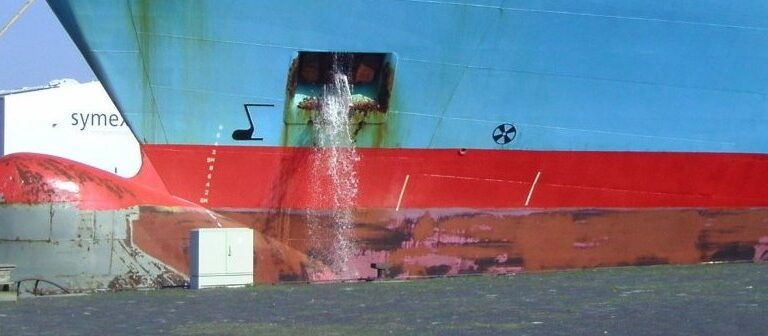
Ballast water is pumped out of a ship, Photo source: National Science Foundation via Wikimedia Commons.
18. Who Calls the Shots on Ships’ Pollution?
Author: Dr. James A. Fawcett, USC Sea Grant Maritime Policy Specialist/Extension Director (retired)
Media Contact: Leah Shore / lshore@usc.edu / (213)-740-1960
In the fall of 1970, my U.S. Navy ship was transiting from Vietnam via Japan back to the U.S. We had taken a great circle route[1] in the transit, resulting in a bit of traffic (we saw one or two ships every two or three days) since other vessels were on similar great circle tracks. One morning I took the watch and noticed a yellow-green stain on the surface of the ocean as far as I could see ahead of us. We were about 800 miles from the nearest land, so it clearly came from a vessel. But what was it?
Over the next couple of days as we gained on the vessel, still seeing the nasty stain, we discovered it was a tankship washing its tanks at sea and disposing of the tank washings overboard. I mention the date because, as you will see, it is relevant. Seafarers for eons have looked at the sea, appreciated its enormous magnitude, and have considered that because of its size, disposing of waste overboard would not cause any significant damage. That all changed in 1973.
The Origin of MARPOL
In 1948 in Geneva, the United Nations met to craft a convention to promote international rules for safety at sea[2]. Until then, the primary requirements were the two Safety of Life at Sea (SOLAS) Conventions of 1914 (developed after the sinking of the RMS Titanic in 1914) and its revision to include a fire code in 1929,[3] and at the convention’s following meeting in 1960, the requirements that were previously applied to only passenger vessels were extended to cargo vessels. However, the convention applied these rules only to signatory maritime states—it was not until 1948 that the UN agreed that effective maritime safety should require regulations to be applied to all vessels and that a newly established international body was the appropriate vehicle to implement those rules, known henceforth as the “Intergovernmental Maritime Consultative Organization” or IMCO. The role of the IMCO, however, has broadened over the years and, indeed, the name of the agency reflects its synoptic coverage of international maritime affairs[4] when it was changed in 1982 to its current name, “International Maritime Organization” or IMO.
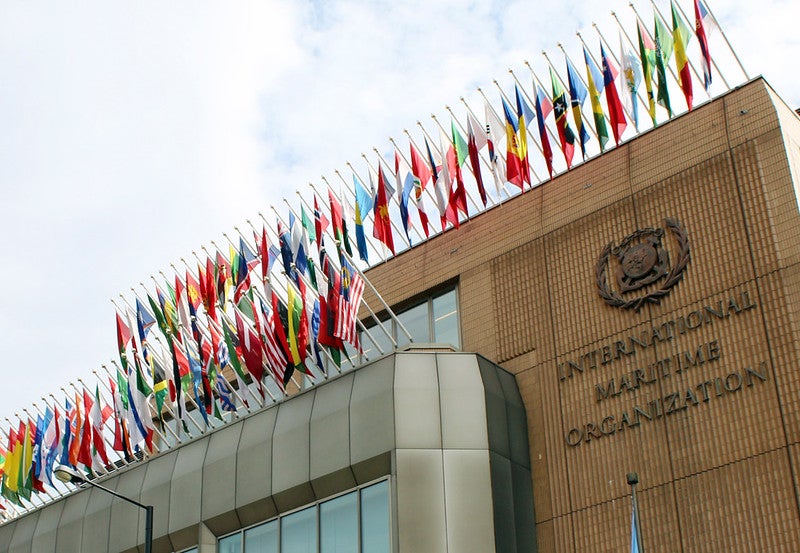
Thus, as one of its first priorities, the new IMCO adopted the SOLAS Convention as one of its responsibilities, and, similarly, in its broader role the renamed agency responded in the early 1970s to concerns over the maritime environment by proposing the International Convention for Prevention of Pollution from Ships, known as MARPOL.[5] Implemented in 1973 and revised in 1978, it has been ratified by more than 170 signatory states. MARPOL has now become the international standard for maritime pollution, and its importance cannot be overstated. Since vessels are registered in many states (known as “flag states”), only an international convention could be effective at setting consistent pollution standards for all of them. Moreover, large areas of the world’s oceans, the “high seas,” are outside of the jurisdiction of any coastal state, and without an international standard for preventing marine pollution, the high seas would be a dumping ground for all manner of pollutants. For mariners, a consistent set of standards was preferable to national standards that could require mariners’ compliance with a variety of regulations depending upon whose waters the vessel sailed—hence the need for a standard that applies to all mariners and all oceans.
The basic agreement to MARPOL was signed in 1973 and revised in 1978 but the details of the convention are found in the annexes that define the requirements for mariners with respect to specific categories of pollutants. Although the original convention was signed in 1973, it had not yet been ratified by the signatory states, so it was not yet in force when there were a series of major oil spills in the 1970s, most notably the Amoco Cadiz off the coast of France in early 1978, spilling 227,000 tonnes[6] of oil. This was preceded by other major spills such as 115,000 tonnes spilled in the Gulf of Oman from the Sea Star in 1972, another 107,000 tonnes from the Texaco Denmark into the North Sea off the coast of Belgium in 1971, and most notably the Torrey Canyon, which spilled approximately 119,000 tonnes in 1967 off the coast of Cornwall in the UK.[7],[8]
Responding to the Amoco Cadiz spill, the international community sought a means of preventing and assessing responsibility for such environmental disasters, inspiring the IMO to formulate what became Annex I of MARPOL, “Regulations for the Prevention of Pollution from Oil.” By doing so, the original parent convention was incorporated into the newly revised 1978 version, which explains its 73/78 designation. Although agreed to in 1978, the convention was not yet ratified by its signatories until October 2, 1983.[9] The subsequent sections are brief summaries of the annexes and their application to maritime pollution.
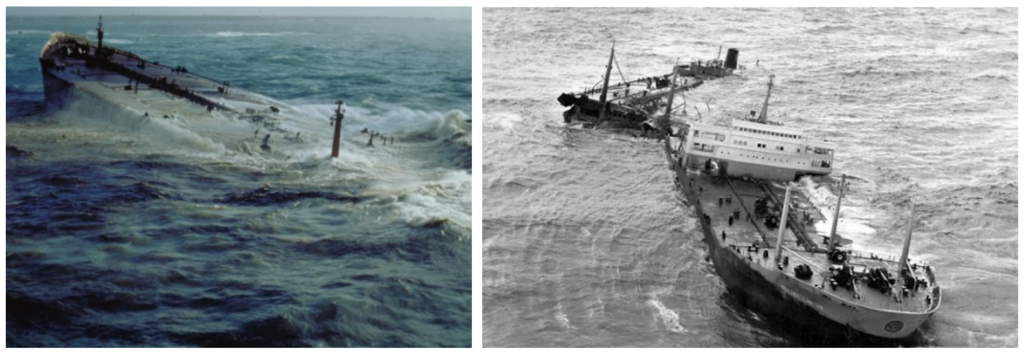
Annex I: Regulations for the Prevention of Pollution by Oil
The Amoco Cadiz spill galvanized public opinion that regulations were needed to prevent such environmental disasters, and at least two major changes in the design of ships were proposed to reduce the chance of spills both in the normal operation of the vessel and if the vessel went aground.
In operation, tankships (tankers) are unique as their liquid cargo also serves to stabilize the vessel in heavy seas and further contributes to stability as it is held low in the vessel hull. That is the good news. The bad news is that most often tankers carry unrefined crude oil that has particularly noxious characteristics when spilled overboard, from damage to wildlife to fouling coastlines. A tanker is stable at sea when it is loaded because of the mass of the cargo. However, when it unloads, it is vulnerable to the sea and must ballast down (take on ballast water) to maintain its seaworthiness. Taking on a subsequent load of oil means that the ballast water must be discharged, and that is a problem if its cargo tanks are used for ballast, and thus containing polluted water. One of the provisions of Annex I is to require segregated ballast in all ships built after 1983, meaning that ballast tanks must contain only seawater thus preventing discharge of oily wastewater when the ballast is discharged and replaced with oil. Back to my story from the beginning, that is exactly what we were seeing at sea in 1970.
The other major requirement of Annex I is that tankships carrying oil after 1983 must be constructed with double hulls, meaning that the skin of the tank carrying oil is separated from the ship’s hull by a void or empty space. The purpose of this design is that, in the case of a collision or allision (contact with a stationary object or another vessel that is stationary), and most especially in the case of a tanker grounding (striking the bottom), that the double-hull will help to prevent a puncture of the oil tank(s). The U.S. has implemented the terms of Annex I through the Oil Pollution Act of 1990.[10] Further, under the Annex, an Oil Record Book must be kept by the vessel recording all discharges of oil or oily waste while at sea. The book must be open to examination by the flag state and states into whose ports the vessel sails.
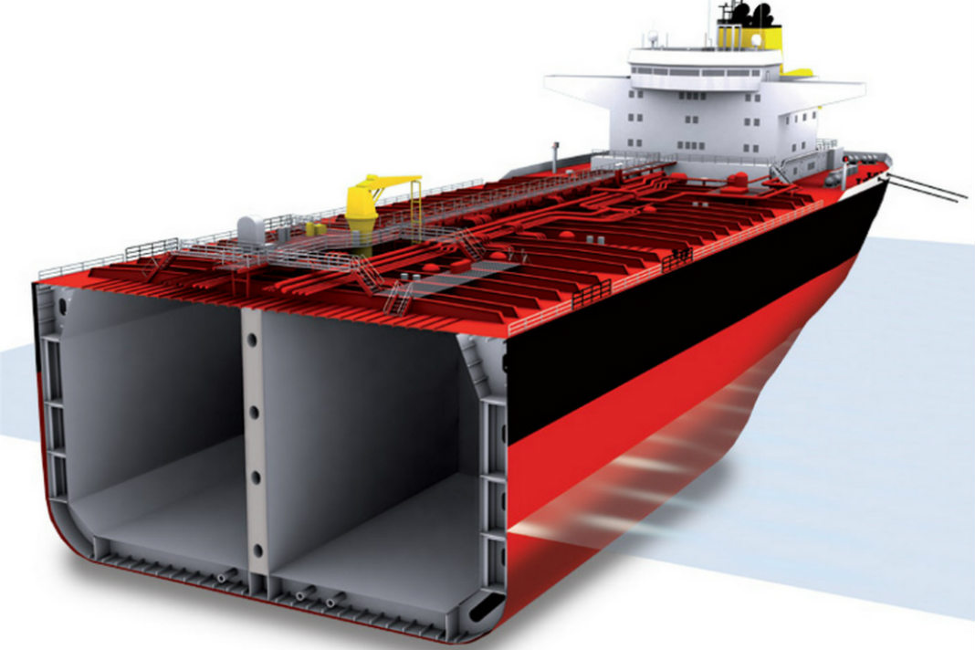
Annex II: Regulations for the Control of Pollution by Noxious Liquid Substances in Bulk
Non-oil cargoes carried in bulk also pose hazards to the marine environment. Annex II makes provisions for these by requiring actions on the part of both carriers and ports. Discharge of pollutants may only be made at port reception facilities and the ability to discharge is defined by the characteristics and concentrations of the cargo being carried. The International Bulk Chemical Code (IBC[11]) is the basis for defining the nature of the cargo and its disposition into reception facilities. In no case may these noxious cargoes be discharged closer than 12 nautical miles from a coastline.
Annex III: Regulations for the Prevention of Pollution by Harmful Substances Carried by Sea in Packaged Form
This Annex was added to MARPOL in 1991 and sets standards for packing, marking, labeling, documentation, stowage, quantity limitations, exceptions, and required notifications for packaged substances carried at sea, some of which are dangerous if discharged by accident overboard. Annex III implements in the marine environment the provisions of the International Maritime Dangerous Goods Code (IMDG).[12], [13] This includes oxidizers, inhalation hazards, poisons, radioisotopes, flammable solids, corrosives, infectious substances, explosives, and a miscellaneous category. The IMDG Code requires standardized labeling informing transportation workers of the nature of the hazard contained in the package. Many of these substances may be carried in intermodal cargo containers that will be appropriately labeled.
Annex IV: Regulations for the Prevention of Pollution by Sewage from Ships
This Annex was added to MARPOL in 2003 and revised in 2005. Annex IV contains a set of regulations regarding the discharge of sewage into the sea from ships, including regulations regarding the ships’ equipment and systems for the control of sewage discharge; the provision of port reception facilities for sewage; and requirements for survey and certification.
It is generally acknowledged that on the high seas, the oceans are capable of assimilating and dealing with raw sewage through natural bacterial action. Therefore, the regulations in Annex IV of MARPOL prohibit the discharge of sewage into the sea within a specified distance from the nearest land, unless otherwise provided. Governments are required to ensure the provision of adequate reception facilities at ports and terminals for the reception of sewage, without causing delay to vessels.
The Annex entered into force on September 27, 2003. A revised Annex IV was adopted on April 1, 2004, and entered into force on August 1, 2005. The revised Annex applies to ships engaged in international voyages, of 400 gross tonnage and above, or which are certified to carry more than 15 persons. The Annex requires ships to be equipped with either an approved sewage treatment plant, an approved sewage comminuting [maceration] and disinfecting system, or a sewage holding tank.[14]
These regulations apply to all oceans, but the IMO specified in 2011 that the Baltic Sea is a “Special Area” that requires additional regulation. Under Resolutions 200(62) and 227(64) of the Marine Environment Protection Committee (MEPC), the IMO specifies that discharge of sewage from passenger vessels sailing in the Baltic is prohibited unless the vessel has an approved sewage disposal plant onboard.[15]
The U.S. is not a party to Annex IV of MARPOL; it regulates sewage discharges under the Clean Water Act (CWA) in U.S. waters. Under Section 402 of the CWA act, which was finalized in 2008, the Vessel Discharge Permit Program (Vessel General Permit), regulates discharges incidental to the normal operation of vessels operating in a capacity as a means of transportation. Recreational vessels as defined in section 502(25) of the CWA are not subject to the VGP. In addition, with the exception of ballast water discharges, non-recreational vessels less than 79 feet (24.08 meters) in length, and all commercial fishing vessels regardless of length, are not subject to the VGP.[16]
It also specifies that foreign vessels sailing in US waters are subject to Annex IV regulations. Section 312 of the Clean Water Act specifies that vessels must have a US Coast Guard Marine Sanitation Device (MSD) aboard and that raw sewage must not be discharged within three miles of a coastline in US navigable waters.
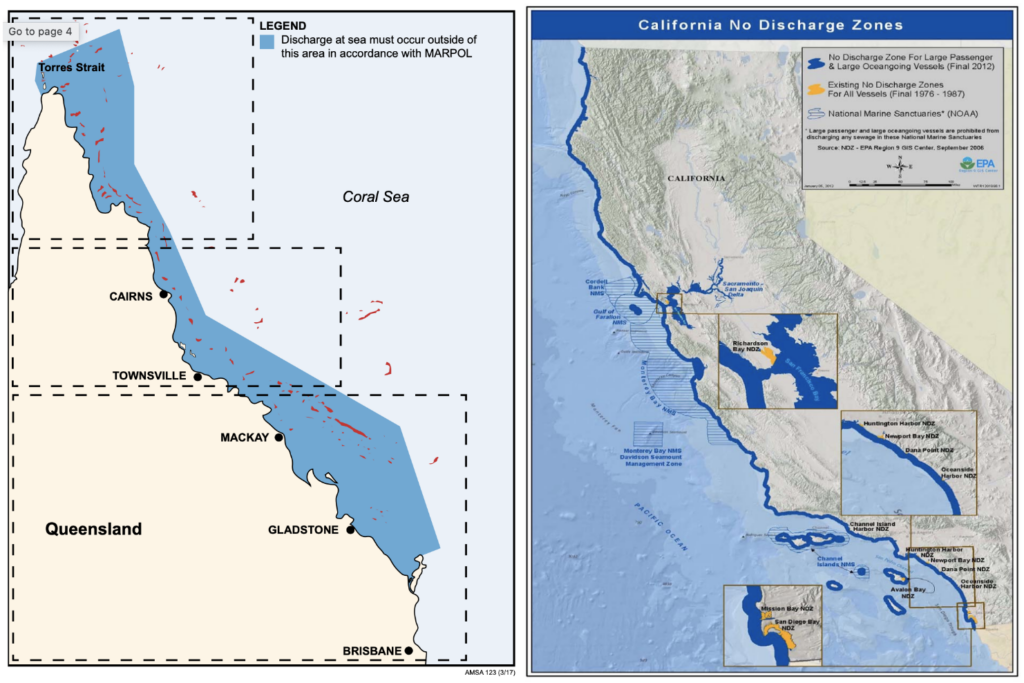
Annex V: Prevention of Pollution by Garbage from Ships
Recognizing that garbage often contains material hazardous to marine life, Annex V was added to MARPOL in 1988 and, like Annex IV, imposed requirements on ports as well as on mariners. The regulations are divided into two basic categories: discharges that are biodegradable and those that are not. Moreover, the regulations are further divided into areas of the world’s oceans that can tolerate discharge of organic/biodegradable material (such as food waste, cargo residues in washwater, animal carcasses, and cleaning agents dissolved in washwater) as detailed in Regulation 4 and other areas needing special protection (specified in Regulations 5 and 6).[17] Regulation 5 covers offshore platforms that are more than 12 nautical miles offshore, including ships alongside within 500 meters of such platforms. Regulation 6 applies to “special areas” and the Arctic region. In these areas, the discharge of garbage is much more restricted.
Even under Regulation 4, the following are prohibited: plastics, synthetic rope, fishing gear, plastic garbage bags, incinerator ashes, clinkers, cooking oil, floating dunnage, lining and packing materials, paper, rags, glass, metal, bottles, crockery, and similar refuse. As specified in the annex, the effectiveness of ships to comply with the discharge requirements of MARPOL depends largely upon the availability of adequate port reception facilities, especially within special areas. Hence, MARPOL Annex V also obliges Governments to ensure the provision of adequate reception facilities at ports and terminals for the reception of garbage without causing undue delay to ships, and according to the needs of the ships using them.[18]
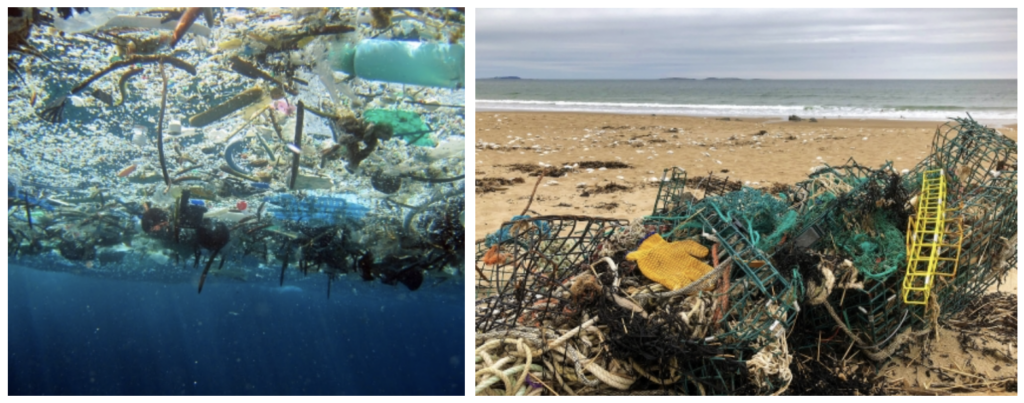
Annex VI: Prevention from Air Pollution from Ships
Annex VI was added to MARPOL in 2005, and a revision was added in 2010. (The original Annex VI was proposed in 1997 and ratified in 2005.) Concerned with exhaust emissions, it covers SO2, NOX, ozone-depleting substances (ODS), and volatile organic compounds (VOCs) from tankers. During the eight years that elapsed between the IMO agreeing to the concept of the annex and its ratification by the required number of states, it became clear that further controls were necessary worldwide on stack emissions from ships. In 2005 at the meeting of IMO’s Marine Environment Protection Committee (MEPC), the committee voted to strengthen existing regulations. The consensus was evident by the rapid ratification of the amendment, and the revision came into force within five years.
The most recent changes to Annex VI have reduced sulfur contents of fuel, the allowable emissions of oxides of nitrogen, allowable emissions of diesel particulate matter (DPM or soot), and the introduction of geographic areas with even stricter emission controls, known as emission control areas (ECAs).
After January 1, 2020, diesel-powered ships must use fuel that contains not more than 0.5% sulfur. Prior to that time, the limit was 3.5% sulfur. For comparison, diesel fuel sold for land transportation purposes in the U.S. now has a limit of 0.05% sulfur. The reduction is designed to reduce photochemical smog and the brown haze it produces on smoggy days.
Oxides of nitrogen are measured in terms of their contribution to exhaust from marine diesel engines and are regulated on a suite and scale of parameters—the US EPA standards are essentially the same as IMO standards. In the ECAs of North America (US and Canada) and around Puerto Rico and the US Virgin Islands (Caribbean ECA), the sulfur limit in fuel is stricter than the worldwide standard (0.10% vs. 0.50%) and the strict NOx Tier III emission standards apply. According to dieselnet.com, within the ECAs in the US, engine manufacturers must verify the durability of their engines to continue meeting the NOx standards; outside of these areas, the IMO requires that the engines meet the NOx standard from the year they were installed.[19]
New ideas are emerging for marine diesel fuels that do not contain sulfur. Ammonia, for example, is a powerful fuel but presents issues because of its toxicity to humans, storage issues, and availability. Another alternative is methanol, which is almost a “drop-in” fuel meaning that it does not need to be refrigerated or pressurized, but marine diesel engines need to be slightly modified and methanol is a fire hazard, burning with an almost invisible flame and low flashpoint. The current trials of some carriers using liquified natural gas (LNG) is not yet definitive. While its emissions are cleaner than standard fuels, its fugitive emissions (methane slip) are a powerful greenhouse gas, and it remains a fire hazard onboard ships as well as needing to be pressurized for storage in onboard fuel tanks. All these alternatives are an effort to reduce the emissions found in current diesel fuels; we can expect a workable alternative to the traditional residual fuels to take time to evolve.
Conclusion
Registered in an array of states, the world’s fleet of cargo ships are essential to world trade and yet pose a threat to the world’s oceans. Eliminating the threat would diminish the quality of life of the world’s population. Therefore, through the IMO, the United Nations has sought to find a balance between economic activity and the environment. MARPOL will undoubtedly be amended and augmented in the future, but as it now stands, the regulatory scheme it has established provides mariners and governments throughout the world with consistent guidance in preventing pollution from our international marine supply chain.
References
[1] A great circle route is the shortest course between two points on a sphere. In a nautical context, in the Pacific Ocean it usually means a northerly route between the West Coast and Asia.
[2] IMO. N.d. Brief History of the IMO. https://www.imo.org/en/About/HistoryOfIMO/Pages/Default.aspx.
[3] IMO. N.d. History of Life-Saving Appliances Requirements. https://www.imo.org/en/OurWork/Safety/Pages/historyofLSA-default.aspx#:~:text=History%20of%20life-saving%20appliances%20requirements%201%201914%20and,4%20Major%20instruments%20dealing%20with%20life-saving%20appliances.%20.
[4] Now including, for example, the International Mobile Satellite Organization (IMSO), the International Safety Management Code (ISM Code), the International Convention on Standards for Training, Certification and Watchkeeping (STCW), the International Safety and Port Security Code (ISPS) and others.
[5] IMO. N.d. International Convention for Prevention of Pollution from Ships (MARPOL). https://www.imo.org/en/About/Conventions/Pages/International-Convention-for-the-Prevention-of-Pollution-from-Ships-(MARPOL).aspx.
[6] A metric ton (tonne) is defined as 1,000 kilograms or 2,204.6 pounds.
[7] Wikipedia. N.d. List of Oil Spills. https://en.wikipedia.org/wiki/List_of_oil_spills
[8] For comparison, the Exxon Valdez in 1989 spilled about 100,000 tonnes of oil into Alaska’s Prince William Sound and the Deepwater Horizon oil platform is estimated to have spilled over 600,000 t into the Gulf of Mexico in 2010.
[9] IMO. N.d. International Convention for Prevention of Pollution from Ships (MARPOL). https://www.imo.org/en/About/Conventions/Pages/International-Convention-for-the-Prevention-of-Pollution-from-Ships-(MARPOL).aspx.
[10] US Environmental Protection Agency. 33 U.S.C. §2701 et seq. (1990). https://www.epa.gov/laws-regulations/summary-oil-pollution-act.
[11] International Bulk Chemical Code (IBC). N.d. International Bulk Chemical Code (IBC). https://www.marinesite.info/2015/09/IBC-Code-international-bulk-chemical-code.html#:~:text=International%20Bulk%20Chemical%20Code%20%28IBC%20Code%29%
20means%20International,committee.%20What%20are%20the%20objectives%20of%20IBC%20code%3F.
[12] IMO. N.d. The International Maritime Dangerous Goods Code (IMDG) Code. https://www.imo.org/en/OurWork/Safety/Pages/DangerousGoods-default.aspx.
[13] IMO. 2021. IMDG Code. https://www.imo.org/en/publications/Pages/IMDG%20Code.aspx.
[14] IMO. N.d. Prevention of Pollution by Sewage from Ships. https://www.imo.org/en/OurWork/Environment/Pages/Sewage-Default.aspx.
[15] IMO. 15 July 2011. AMENDMENTS TO THE ANNEX OF THE PROTOCOL OF 1978 RELATING TO THE INTERNATIONAL CONVENTION FOR THE PREVENTION OF POLLUTION FROM SHIPS, 1973; (Special Area Provisions and the Designation of the Baltic Sea as a Special Area under MARPOL Annex IV). https://wwwcdn.imo.org/localresources/en/OurWork/Environment/Documents/200(62).pdf.
[16] US Environmental Protection Agency. N.d. Vessel Sewage Discharges: Statutes, Regulations and Related Laws and Treaties. https://www.epa.gov/vessels-marinas-and-ports/vessel-sewage-discharges-statutes-regulations-and-related-laws-and.
[17] IMO. N.d. Simplified overview of the discharge provisions of the revised MARPOL Annex V which entered into force on 1 March 2018. https://wwwcdn.imo.org/localresources/en/OurWork/Environment/Documents/Simplified%20overview%
20of%20the%20discharge%20provisions%20of%20the%20revised%20MARPOL%20Annex%20V.pdf.
[18] IMO. N.d. Prevention of Pollution by Garbage from Ships. https://www.imo.org/en/OurWork/Environment/Pages/Garbage-Default.aspx.
[19] Dieselnet.com. N.d. United States: Marine Diesel Engines. https://dieselnet.com/standards/us/marine.php.